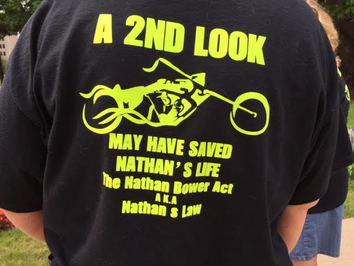
The Nathan Bower Act, signed by Gov. Rick Snyder last October, was named after a 19-year-old
motorcyclist killed when a car hit him in 2009.
The act requires that driver education include information
about laws pertaining to bicyclists and motorcycles, and how to safely share
the road with them.
Tammy Bower, Nathan’s mom, said a driver who was in a hurry
didn’t look twice before pulling out in front of Nathan’s motorcycle. His death prompted Tammy, from Michigan’s Thumb, to advocate for "Nathan's Law."
At an August motorcycle safety event at the Michigan Capitol, she sported a T-shirt saying “A 2nd look may have saved
Nathan’s life.”
The Department of State has compiled a list of educational resources for bicycle and motorcycle safety.
Cyclists can be hard to see. If you’re stopped at an
intersection, look left, center, right and then left again, and repeat as needed to ensure the road is
clear. That second look can prevent tragedies.
 Wanted: 50 Michigan high schools to participate in Strive for a Safer Drive (S4SD), aimed at reducing traffic crashes involving teen drivers.
Schools receive up to $1,000 to develop a peer-to-peer traffic safety awareness campaign. The top five will receive cash prizes.
More information: S4SD website; (517) 241-2533 or strive4asaferdrive@gmail.com. Proposals are due by Nov. 20.
S4SD is sponsored by Ford Driving Skills for Life and the Michigan Office of Highway Safety Planning.
|
|